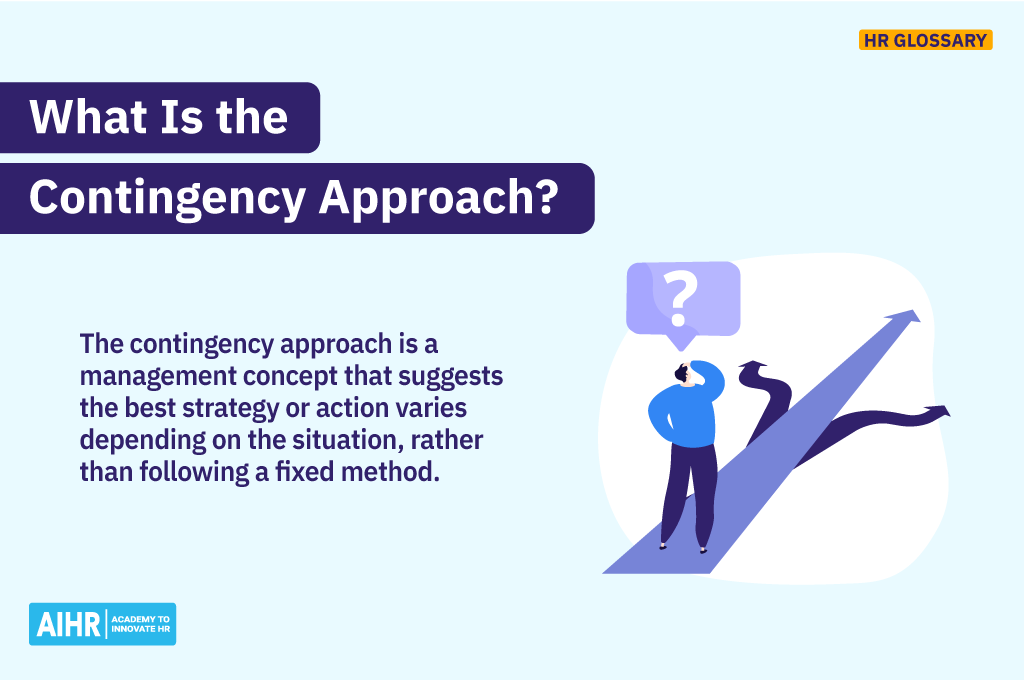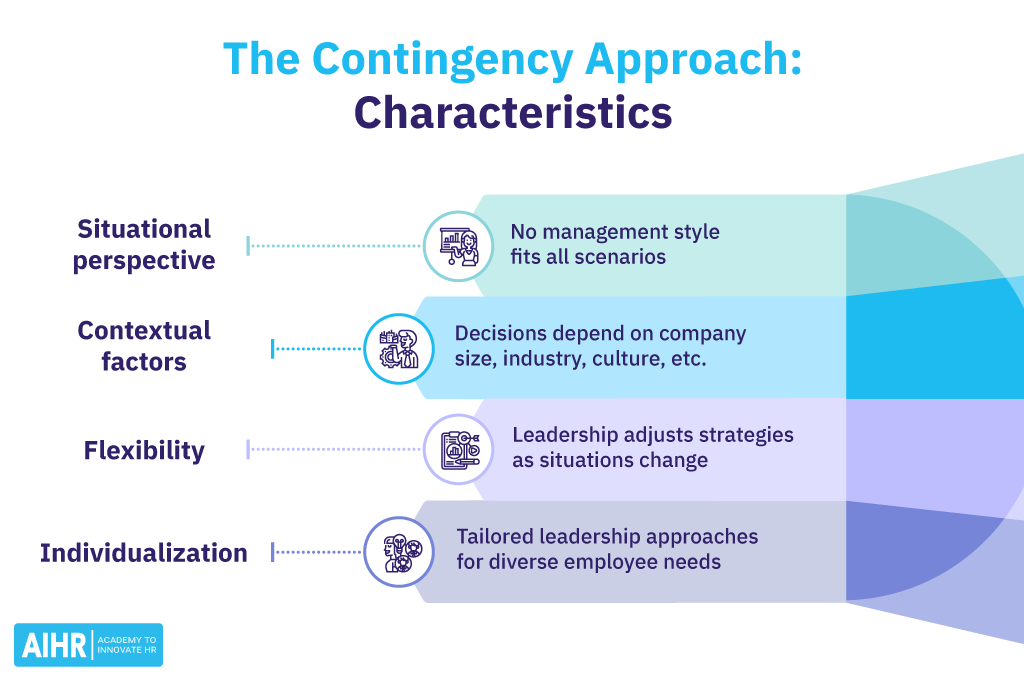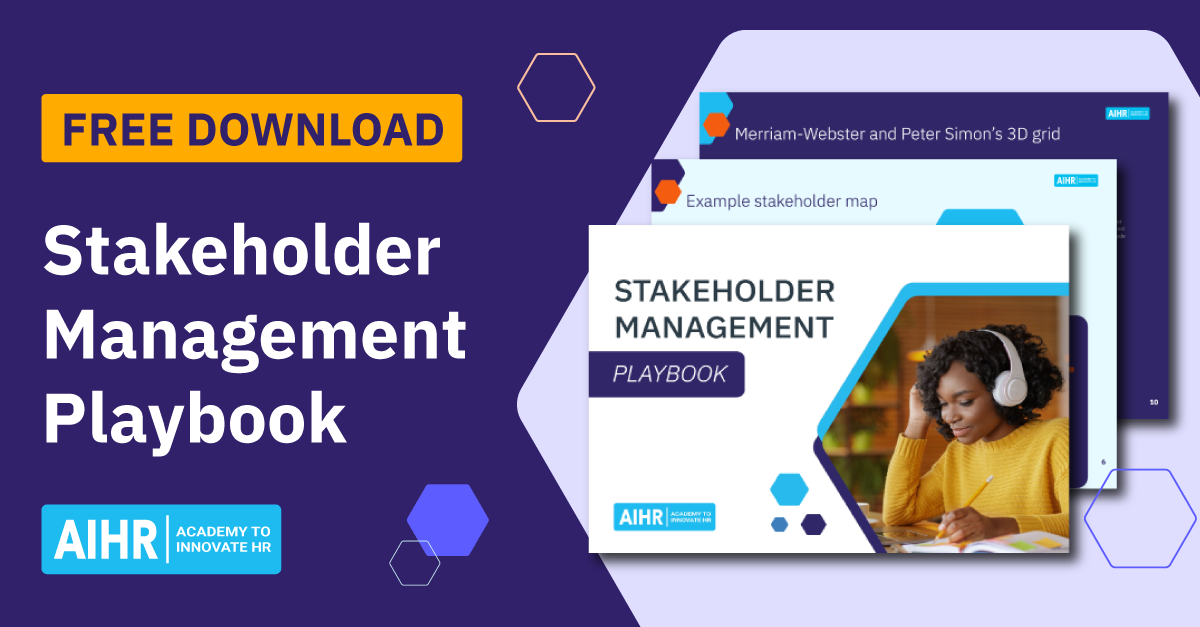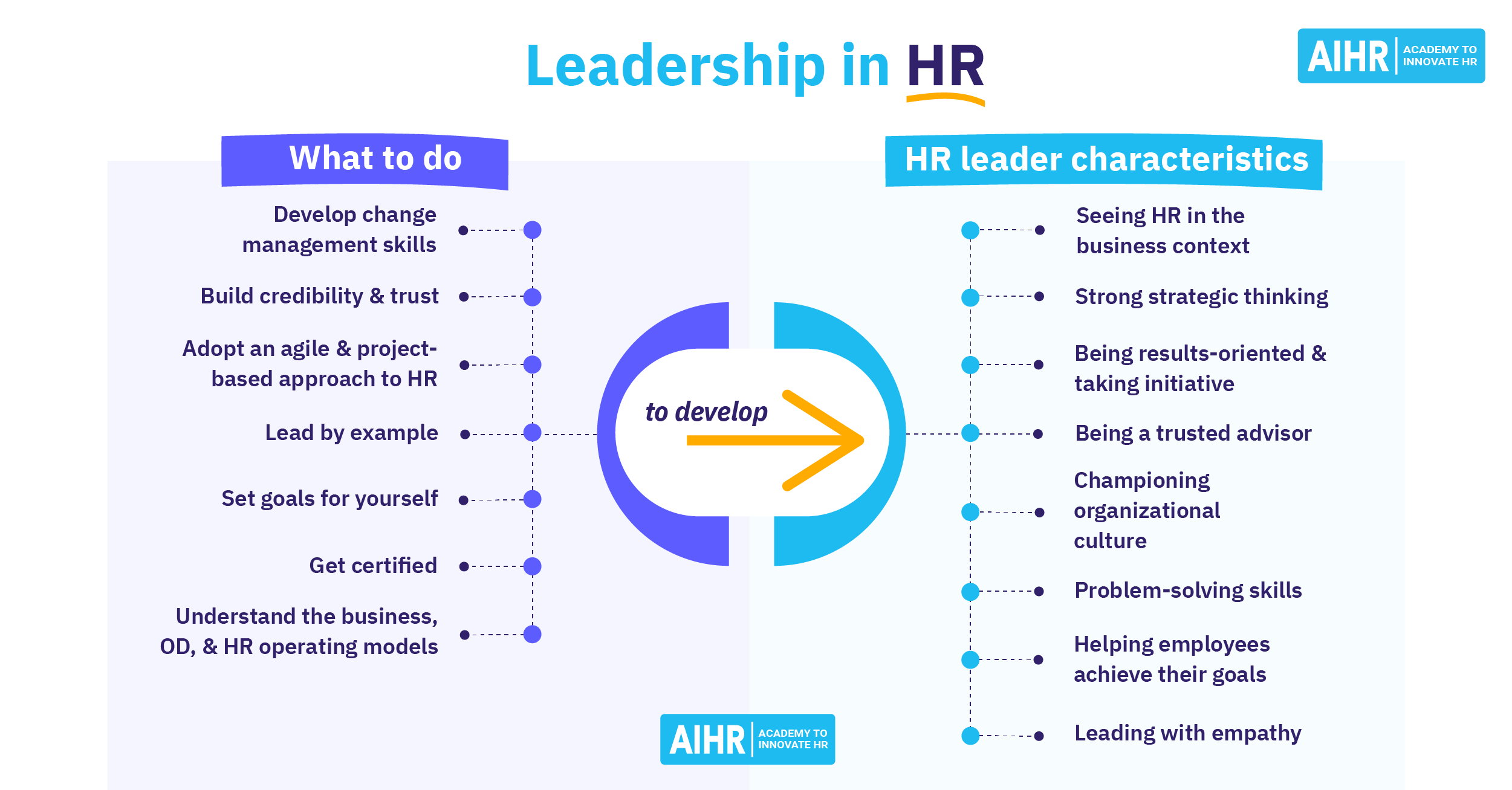Contingency Approach
What is the contingency approach?
The contingency approach is a management theory that suggests there’s no single best way to manage an organization. Instead, the most effective management style or organizational structure depends on the specific circumstances or context in which a company operates. This approach takes into account factors like the external environment, nature of each task, workforce, and organizational culture, and it tailors management practices to fit these variables.
Often referred to as contingency theory or contingency approach to management, this concept recognizes the dynamic and ever-changing nature of the workplace. It emphasizes the need to adapt HR practices to suit an organization’s unique circumstances, ultimately leading to more effective decision-making and problem-solving.

What are the 4 contingency approaches?
The contingency approach encompasses various theories, offering a distinct perspective on managing organizations. These theories are:
1. Fiedler’s Contingency Theory
Fiedler’s Contingency Theory posits that a leader’s effectiveness is determined by the match between their leadership style (task-oriented or relationship-oriented) and the specific situation. The situation is assessed based on three factors: leader-member relations, task structure, and the leader’s positional power.
Fiedler’s Contingency Theory example
A task-oriented manager excels in a structured production environment but struggles when transferred to a less structured, relationship-driven customer service role. Their effectiveness depends on the fit between their style and the environment.
2. Situational Leadership Theory
The Situational Leadership Theory, developed by Paul Hersey and Ken Blanchard, suggests leaders should adapt their style based on the readiness or maturity of their followers. The theory identifies four leadership styles — Telling, Selling, Participating, and Delegating — each suited to different levels of employee competence and commitment.
Situational Leadership Theory example
A manager uses a directive approach (Telling) with a new, inexperienced team member and gradually shifts to a more hands-off style (Delegating) as they become more skilled and confident.
3. Path-Goal Theory
The Path-Goal Theory, developed by Robert House, focuses on how leaders can motivate their followers to achieve goals by clarifying the path to success, removing obstacles, and providing support. The theory suggests leaders can adapt their behavior to fit their team’s needs using directive, supportive, participative, or achievement-oriented styles.
Path-Goal Theory example
A sales manager clarifies goals and provides additional training to help the team overcome challenges, while also offering incentives to boost motivation. This approach helps the team achieve their targets by ensuring they have a clear path and the necessary support.
4. Decision-Making Theory
The Decision-Making Theory in management proposes that managers tailor their decision-making approach based on the situation. Depending on the problem’s complexity and urgency, managers might choose autocratic, consultative, or participative decision-making styles.
Decision-Making Theory example
A startup CEO uses an autocratic leadership style for technical decisions requiring quick action, a participative leadership style for decisions affecting company culture, and a consultative approach for routine decisions, adapting her style to the specific needs of each situation.
Characteristics of the contingency approach
The contingency approach to leadership is characterized by several fundamental principles, including:
- Situational perspective: The approach recognizes there is no one-size-fits-all solution or management style. Different scenarios require different directions, and HR professionals must adapt accordingly.
- Contextual factors: The effectiveness of management practices depends on several contextual factors, including the organization’s size, industry, technology, culture, goals, and external environment. These factors should inform decision-making and leadership style.
- Flexibility: Managers should be flexible in their approach and willing to adjust their strategies based on changing situations. What works well in one case may not work in another. Flexibility is a cornerstone of the contingency approach.
- Individualization: The contingency approach encourages individualized approaches to leadership and management. It acknowledges that employees have diverse needs and motivations. This means leaders must tailor their management practices accordingly to meet these unique requirements, ultimately enhancing performance.

Contingency approach examples in the workspace
Leadership adaptation in a multinational corporation
In a multinational corporation, contingency leadership is evident in many styles across different regions. For instance, a Europe-based company expanding into Asia may adopt a more participative and relationship-oriented leadership style when dealing with Asian teams to ensure alignment with cultural expectations.
Flexible work arrangements during a crisis
Amid the COVID-19 pandemic, organizations worldwide had to swiftly adapt to remote work arrangements. HR played a pivotal role in implementing these changes. Based on the nature of the job, HR teams had to customize remote work policies. For instance, HR encouraged virtual meetings and project management tools for roles that required constant collaboration. For functions that could operate independently, flexible working hours were introduced.
Tailored training programs
In a manufacturing company, HR realized employees on the production line needed a distinct training approach compared to those in research and development. While the former required hands-on, task-oriented training to ensure safety and efficiency, the latter needed a more self-directed approach that fostered creativity. HR’s ability to customize training methods based on the specific needs of each department exemplifies the contingency approach.
Adapt your leadership style with the contingency approach
The contingency approach emphasizes that there’s no one-size-fits-all way to manage an organization. Effective leadership depends on factors like environment, workforce, and task complexity. By understanding this approach, HR professionals can tailor strategies to fit specific situations.
Our HR Manager Certificate Program helps you develop this adaptive mindset, equipping you with the skills to handle diverse challenges in a dynamic workplace. Start enhancing your leadership capabilities today!
Why HR should understand and apply the contingency approach
HR professionals should embrace the contingency approach for several reasons:
- HR practice customization: The contingency approach highlights the need to tailor organizational practices, including HR policies and procedures, to each specific situation. This customization ensures HR initiatives align with the organization’s goals, structure, and environment, bringing about greater effectiveness.
- Resource optimization: By applying the contingency approach, HR professionals can allocate resources more efficiently. For example, HR can focus on recruitment and training during a period of rapid growth, and prioritize cost-saving measures and workforce planning during a downturn.
- Enhanced decision-making: Understanding the contingency approach equips HR professionals to make better decisions. They can assess each situation’s unique circumstances, weigh contextual factors, and choose the most appropriate course of action, leading to better outcomes.
- Increased flexibility: The contingency approach encourages HR professionals to be adaptable in their strategies. This flexibility allows them to respond effectively to unexpected challenges, such as market shifts or changes in employee needs, ensuring HR remains aligned with the broader organizational context.
- Improved employee engagement: By tailoring HR practices to the specific needs and circumstances of different teams or departments, HR can create a more supportive and responsive work environment. This approach can lead to higher employee satisfaction and engagement, as employees feel their unique needs are being recognized and addressed.
The contingency approach is a valuable framework for HR professionals. It enables them to navigate the complexities of the modern workplace effectively. HR professionals who embrace this leadership strategy can optimize their practices, enhance decision-making, and contribute to the organization’s success in a dynamic and ever-changing business environment.
FAQ
The contingency approach is a management theory that suggests there is no one-size-fits-all method for managing an organization. Instead, the best course of action depends on the specific circumstances, including the environment, tasks, and people involved. Managers need to adapt their strategies and practices to fit the unique situation they are facing.
An example of contingency theory is seen in leadership styles. For instance, a manager might use a directive leadership style in a highly structured environment where tasks are clear, and employees need close supervision. However, the same manager might adopt a more participative approach in a creative, less structured environment where employees are encouraged to share ideas and make decisions. The effectiveness of the leadership style depends on the specific context, illustrating the core idea of contingency theory: the best approach varies based on the situation.
The contingency approach offers several advantages. It provides flexibility by allowing managers to adapt their strategies to specific situations, leading to more effective decision-making. Since it considers the unique factors of each scenario, the solutions are more relevant to the organization’s actual needs. This approach also fosters better problem-solving, as it encourages tailored, innovative solutions. Additionally, it helps managers handle the complexities of different environments by offering a range of tools and methods to choose from.









